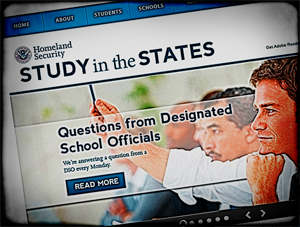The Student and Exchange Visitor Program (SEVP) is the sleepiest of the immigration-management agencies — and that's saying a lot. Its task is to monitor nearly 9,000 educational entities, which, in turn, are supposed to monitor more than a million foreign students (as well as the foreign graduates who are working in the OPT program).

It also has an odd appeals structure that chugs into motion only when SEVP denies some (usually tiny) school the right to issue the paper that creates F-1 visas.
Instead of channeling its appeals to such independent, quasi-judicial organizations as the immigration courts, the USCIS Administrative Appeals Office, or the Board of Immigration Appeals — each of which has separate corps of judges and adjudicators — SEVP turns inward. It has created the SEVP Appeals Team (SAT) and it consists of some SEVP staff members reviewing the negative decisions made by other SEVP staffers. It all sounds a bit claustrophobic, if not incestuous.
But there is not much to review. The Center for Immigration Studies filed a FOIA request with SEVP's mother organization, ICE, and received 379 pages of SAT decisions for the period December 2011 through September 2014. There were 95 decisions in those years, or about 32 a year. These decisions, unlike those of AAO, are not routinely made public.
There are very few decisions compared to the 8,979 schools licensed by SEVP; the annual percentage is 0.3 percent, meaning that there were very few denials, or at least only a handful of them were regarded as worthy of an appeal.
The institutions appealing to SAT are not only usually quite small, all but one of them had names that were new to me, with the exception being one of DeVry University's many campuses. (That's a private, for-profit school, as are nearly all of the appellees.)
As a sampling of the names, these schools were the subject of September-December 2013 decisions:
- A-Cent Aviation, Inc.
- Concord Rusam
- Northbrook Academy
- Techni-Pro Institute
- Lincoln-Marti Community Agency
- Arizona School of Integrative Studies
- Northern Educate Hockey Academy LLC
- Computer Training Institute of Chicago
I was hoping for the Fly-by-Night College of Aviation or the U R So Beautiful School of Cosmetology, but was thwarted, though I think A-Cent Aviation is a fun name. That school, incidentally, was one of the few to get anything like a favorable decision from SAT, in its case there were several rulings, one of which was sought by the school and the others against it.
The name Northern Educate Hockey Academy also intrigued me, as it mixed a noun (academy) and two words used as adjectives (northern and hockey) with one verb (educate) in what struck me as an awkward way.
This is an unusual school, as this for-profit entity combines lots of ice hockey practice (aka ice time) in the mornings with on-line high school education in the afternoons, according to the Minneapolis Star-Tribune.
SEVP nixed its application because it was both unaccredited and could not meet the SEVP standards for unaccredited schools of having had three of its graduates accepted at accredited schools. NEHA said it did not yet have any graduates, as it was a new entity. It also missed the deadline for filing an appeal with SAT and thus did not secure an SEVP license. Neither NEHA nor a successor institution, Achievers' Academy, are currently on the SEVP list of approved schools, which can be seen here.
Generally SAT supports the staff's negative decisions, which is not surprising given the fact that an institution has to be in very bad shape before SEVP notices. What SEVP, an arm of ICE, appears to do is to sort out and reject the most marginal entities wanting to bring in foreign students, but only those at the very bottom of the barrel.
As we have pointed out in the past, visa mills, such as Tri-Valley University in California and the University of Northern Virginia, had the blessing of SEVP for many years before that agency finally caught up with them.
I am grateful to two CIS interns for their assistance: Dylan Thomas, who secured the data, and Cody Donald, who helped analyze it.
